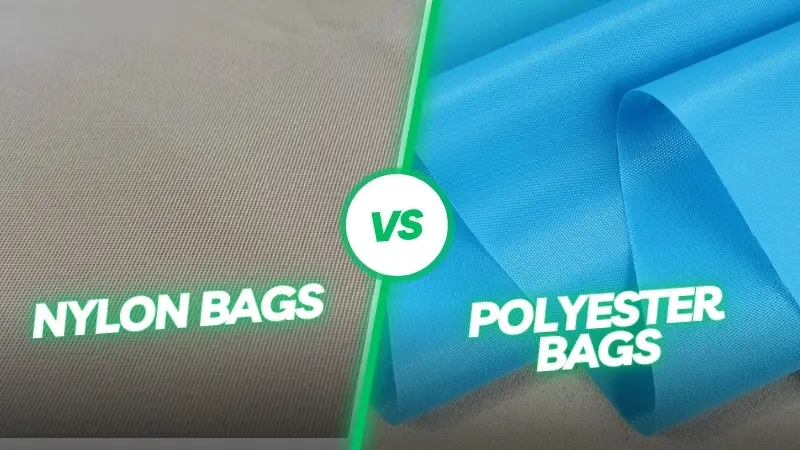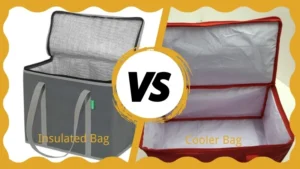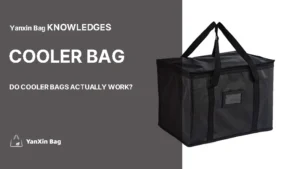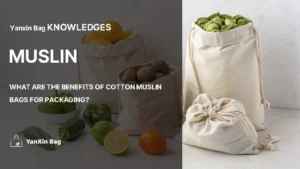Last Updated on 2025-06-15 by Jacky Zhou
Nylon bags and polyester bags are widely used in daily life and work due to their durability and versatile design. Whether for shopping, gym use, or travel, these bags offer ideal solutions to meet various needs.
What Are the Differences Between Nylon Bags and Polyester Bags?
Nylon bags are made from polyamide, offering extremely high strength and elasticity, with excellent tear resistance and abrasion resistance. They are ideal for carrying heavy loads and frequent use, such as hiking backpacks and travel bags. Nylon bags also have strong water resistance, making them suitable for outdoor and humid environments. However, their UV resistance is poor, and prolonged exposure to sunlight may cause fading. Nylon bags are usually sturdy, with high density and a glossy appearance, and are more expensive than polyester bags.
Polyester bags are made from polyester, which is more economical and suitable for everyday use, such as shopping and carrying daily items. Polyester bags excel in color fastness and UV resistance, making them less likely to fade. However, their water resistance is weaker, and they are not suitable for long-term exposure to humid environments. Polyester bags are lighter, softer, and have a simple appearance, making them ideal for everyday use, and are more affordable.
Although the main differences between nylon bags and polyester bags have been introduced, understanding their detailed comparison in terms of performance, durability, and appearance can help you make a better choice. Keep reading to dive deeper into the differences between these two types of bags in key characteristics, and find the one that best suits your needs.
Nylon bags are more water-resistant than polyester bags. True
Nylon has better inherent water resistance and can be treated for even stronger waterproofing.
Polyester bags are more durable than nylon bags. False
Nylon is generally more durable and resistant to tearing and abrasion compared to polyester, making it the more long-lasting option.
What Is A Nylon Bag?
Nylon bags are very popular due to their excellent durability and high strength, making them ideal for carrying heavy loads or frequent use. They are generally lightweight, strong, and offer better water resistance, making them suitable for outdoor and humid environments. Nylon bags are highly durable and stand the test of time, but they are relatively expensive. Compared to bags made from other materials, nylon bags have superior tear resistance and abrasion resistance, making them perfect for high-demand items like backpacks and shopping bags.
What Is A Polyester Bag?
Polyester bags are a more economical choice, typically suitable for everyday use, such as shopping and carrying daily items. While polyester bags are not as strong as nylon bags, they excel in color fastness and UV resistance, making them less likely to fade. Polyester bags have weaker water resistance, so they are not suitable for long-term exposure to humid environments. However, due to their lower production cost and relatively lighter weight, polyester bags are a common choice for everyday shopping, packaging, and similar uses.

What’s the difference between Nylon Bag and Polyester Bag?
Chemical Composition and Structure:
- Nylon Bags: Nylon bags are made from polyamide (Nylon), and their molecular structure contains amide bonds (-CONH), which give them extremely high strength and elasticity. This structure provides nylon bags with strong resistance to stretching and wear, making them suitable for handling significant pressure.
- Polyester Bags: Polyester bags are made from polyester, which has ester bonds (-COO) in its structure, giving them better water resistance and chemical stability. Polyester bags perform well in everyday use but are slightly less durable than nylon.
Thickness Comparison:
- Nylon Bags: Nylon bags are typically sturdier, with higher density, so even thinner versions still offer good durability and strength. Nylon bags can be made in different thicknesses depending on the need, commonly used for heavy-duty backpacks, travel bags, and other items that need to carry heavier loads. While thinner nylon versions are suitable for daily use, their thickness and density generally provide better durability.
- Polyester Bags: Polyester bags are generally lighter and softer, making them ideal for creating lightweight bags such as shopping bags and portable bags for everyday use. While polyester bags also come in thicker versions, thinner polyester bags feel softer and more comfortable compared to nylon. Therefore, polyester bags focus on being lightweight and comfortable, rather than strong and durable.
Appearance Comparison:
- Nylon Bags: Nylon bags typically have a certain glossy appearance, with a smooth surface that gives a modern and stylish feel. This glossiness makes nylon bags more attractive in appearance, making them ideal for high-end products like backpacks and sports gear.
- Polyester Bags: Polyester bags usually have a flatter appearance, giving a simple, clean impression. The texture of polyester is typically not as smooth as nylon, so they are less fashionable but more suitable for everyday uses, such as clothing bags and eco-friendly bags.
Durability and Strength:
- Nylon Bags: Nylon bags are extremely durable, with high resistance to tearing and abrasion. Even in harsh environments, nylon bags can withstand significant tension, making them suitable for frequent use and carrying heavy items like hiking backpacks or travel bags.
- Polyester Bags: Polyester bags are also quite durable, but compared to nylon, their resistance to stretching and abrasion is slightly lower. Polyester bags are ideal for everyday lightweight use, such as shopping bags and packaging, but may not last as long as nylon bags for heavy-duty use.
Water Resistance Comparison:
- Nylon Bags: Nylon bags have strong water resistance, especially when treated with special coatings, effectively preventing water from penetrating. Nylon bags are commonly used in situations requiring high water resistance, such as outdoor sports and rain gear.
- Polyester Bags: Polyester bags also have good water resistance, especially when treated with a coating, which improves the water resistance compared to regular polyester material. However, compared to nylon bags, polyester bags have slightly weaker water resistance, making them suitable for mildly damp environments.
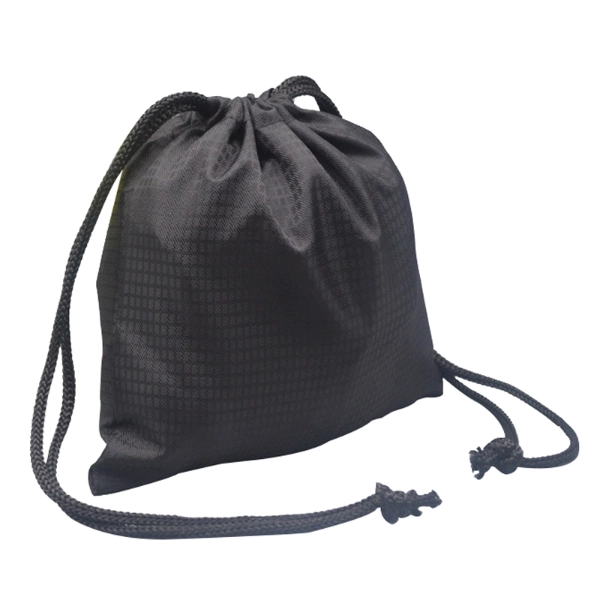
Comfort:
- Nylon Bags: Nylon has high moisture absorption, which makes nylon bags generally soft and comfortable to wear and use. Due to its good elasticity and softness, nylon is also suitable for making intimate clothing such as underwear or outerwear.
- Polyester Bags: Polyester has low moisture absorption, meaning it may feel dry and cool when worn or used. Polyester bags are suitable for summer wear or applications where dryness is needed, but they are less commonly used for intimate products.
UV Resistance and Color Fastness:
- Nylon Bags: Nylon bags are more susceptible to UV rays, and prolonged exposure to sunlight can cause fading or a decrease in material strength. Therefore, nylon bags need to be carefully protected from prolonged sun exposure when used outdoors.
- Polyester Bags: Polyester bags have strong UV resistance, and even with long exposure to intense sunlight, they are less likely to fade. The color and printed designs on polyester bags are better maintained, making them suitable for long-term outdoor use.
Environmental Impact Comparison:
- Nylon Bags: The production of nylon consumes more energy and has a greater environmental impact, especially since harmful substances may be released during manufacturing. However, nylon is recyclable, and many brands are beginning to use recycled nylon materials to reduce environmental impact.
- Polyester Bags: Polyester has a more mature recycling technology, and recycled polyester (rPET) is widely used globally. Polyester bags are more environmentally friendly as they can effectively reduce plastic waste, making them a more eco-friendly synthetic fiber.
Printing Comparison:
- Nylon Bags: Nylon bags have a smooth surface, making them suitable for high-quality printing where patterns and colors are clearly displayed. The surface of nylon allows for vibrant and detailed designs, making it ideal for various printing needs, especially for high-end custom products.
- Polyester Bags: Polyester bags also have a smooth surface, making them suitable for heat transfer printing and screen printing. They provide uniform colors and clear designs, and are widely used for custom apparel and promotional printed products. The printing effect on polyester is generally more consistent, showcasing long-lasting colors.
Price Comparison:
- Nylon Bags: Due to the relatively complex production process and higher raw material costs, nylon bags are generally more expensive. They are suitable for products requiring high strength and durability.
- Polyester Bags: Polyester has a lower production cost, making polyester bags more economical. They are ideal for everyday use and meet the demands of large-scale production.
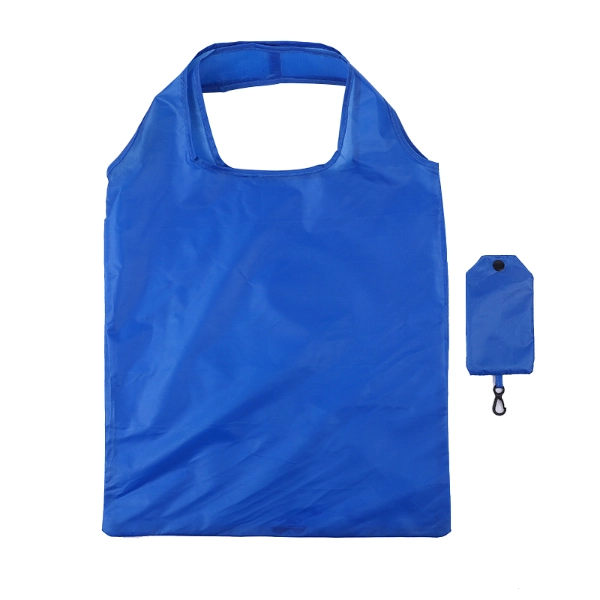
Conclusion
Through a detailed comparison of nylon bags and polyester bags, we can see the advantages and disadvantages of each. Nylon bags, with their superior durability, water resistance, and abrasion resistance, are ideal for carrying heavy loads and for high-intensity use. On the other hand, polyester bags, being lightweight, economical, and offering strong UV resistance, are an ideal choice for everyday use. Choosing the right material based on your needs will better meet the specific requirements of your intended use. Understanding the characteristics of each material will help you find the most suitable bag, ensuring the best performance.
If you’re looking for high-quality nylon or polyester bags to meet various needs, feel free to contact us. We offer expert advice and high-quality products to help you select the most suitable material, enhancing your brand image. Contact Yanxin Bag today for a free design consultation and samples, and let us customize the perfect bags for your brand!
Additional Resources
You can learn more detailed information about polyester bag on Wikipedia.
You can learn more detailed information about nylon bag on Wikipedia.
For detailed information on different printing techniques, visit Printing News.
FAQs
Q1: What is the main difference between nylon and polyester bags?
Answer: Nylon bags are more durable, stronger, and have better water resistance compared to polyester bags. Nylon is suitable for heavy-duty use and outdoor environments. Polyester bags are lighter, more affordable, and resistant to fading and UV rays, but they have weaker water resistance.
Q2: Is polyester a plastic or cotton?
Answer: Polyester is a synthetic polymer made from petrochemical products, so it is considered a plastic. It is not derived from cotton.
Q3: Is polyester healthier than cotton?
Answer: Polyester is less breathable and moisture-wicking compared to cotton. Cotton is natural, softer, and more breathable, making it generally healthier for skin contact and summer wear.
Q4: Does polyester shrink in the washer and dryer?
Answer: Polyester is generally resistant to shrinking, but high temperatures in washing or drying can cause slight shrinkage. It’s best to wash polyester in cold water and air-dry it to maintain its size.
Q5: Can I iron polyester?
Answer: Yes, you can iron polyester, but it should be done on a low heat setting to avoid damaging the fabric. Using a steam iron can help smooth wrinkles without applying direct heat.
Q6: How does the strength of nylon compare to polyester?
Answer: Nylon is stronger and more durable than polyester. It is more resistant to tearing and wear, making it suitable for high-stress applications like backpacks and luggage.
Q7: Which bag is better for eco-friendliness, nylon or polyester?
Answer: Both materials have environmental concerns, but polyester is more commonly recycled (e.g., rPET). Nylon production can release harmful chemicals, but recycled nylon options are becoming more available.
Q8: Are nylon bags cheaper than leather bags?
Answer: Yes, nylon bags are typically cheaper than leather bags. Leather is a natural material and its production process is more complex, making it more expensive.

